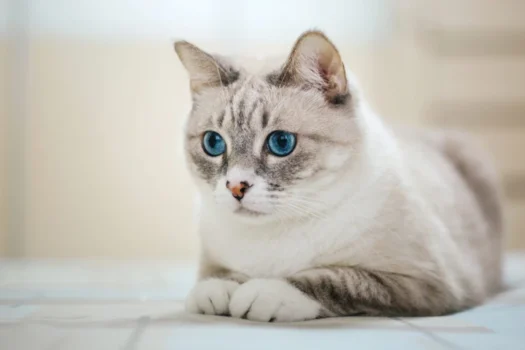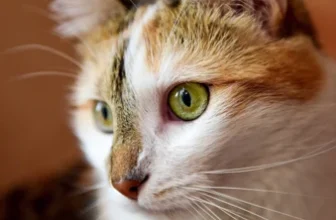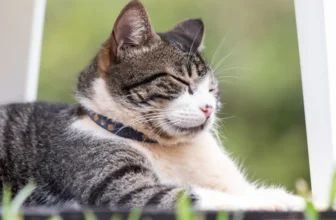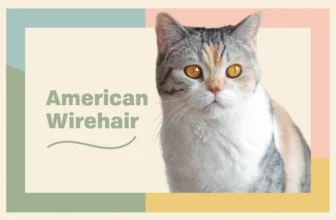The American Wirehair cat is a unique breed that stands out from other domestic cats because of their distinctive wiry fur. If you’re a proud owner of an American Wirehair, you may have noticed that your cat has a variety of different coat colors and patterns. While some may assume that this breed only comes in brown or black, there are actually many variations of colors and patterns that these cats come in. In this article, we’ll delve into the world of American Wirehair cat coat colors, what they mean, and tips for grooming your beloved feline friend. So sit back, relax, and let’s explore the colorful world of American Wirehair cats!
Understanding American Wirehair Cat Colors
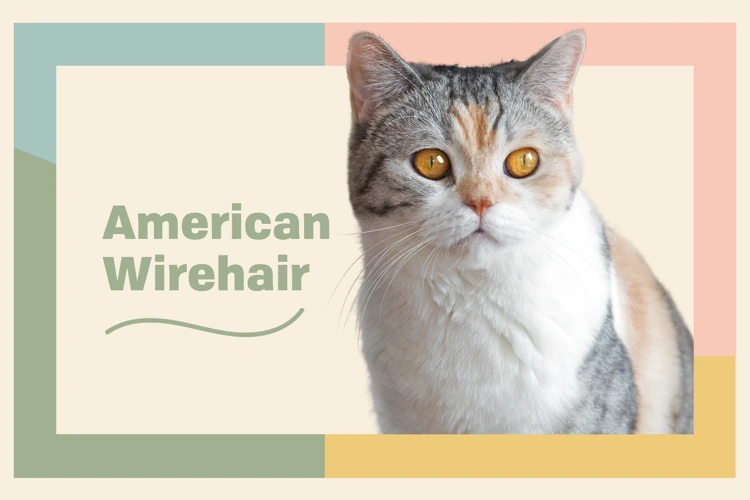
American Wirehair cats are known for their unique and distinctive coat that looks tangled and messy, but is actually quite soft to the touch. The breed comes in a wide variety of colors and patterns, which makes them even more beautiful and unique. So, let’s take a closer look at American Wirehair cat colors and what makes them so special.
Brown Tones
American Wirehair cats have a range of browns in their coat color palette, such as chocolate, cinnamon, and sable. These shades are darker and more intense, adding a touch of elegance to the breed. Some have a reddish tint to their brown, while others have a more muted beige undertone.
Black
Black is a dominant color among American Wirehair cats. Their rich black coat looks stunning, especially when it shimmers in the sunlight. Black American Wirehair cats can come in various shades, from a pitch black to black with a hint of brown.
White
While American Wirehair cats are known for their wild-looking coats, many also sport a beautiful white coat. The coat is typically snow white and impeccably plush, which makes these cats look like living snowballs. Some American Wirehair cats may be mostly white, with small patches of other colors.
Blue
The blue American Wirehair cat has a lavender-blue coat that is quite rare among cats. It is a captivating color that looks ethereal and mystical.
Red
American Wirehair cats may also have a coat that is a vibrant shade of red. This bright and bold color looks gorgeous on an American Wirehair cat and is sure to turn heads.
Cream
Some American Wirehair cats have a creamy, warm coat that looks like a luxurious cashmere sweater. This is a soothing and undeniably beautiful coat color that brings warmth and comfort.
Silver / Gray
The silver/gray American Wirehair cat has a coat that looks like a magical silver lining. This color is unique and extraordinary, adding a touch of glamour to the breed.
Points
American Wirehair cats may have points that look strikingly similar to the Siamese breed. However, unlike the Siamese breed, American Wirehair cats can come with points in a vast array of colors. Some common point colors include seal, chocolate, and lilac.
Tabby Patterns
Tabby patterns are prevalent among American Wirehair cats. These patterns look like a luxurious tapestry, ranging from classic stripes to spots and marbled patterns.
Calico / Tortoiseshell
The calico or tortoiseshell patterns are quite common among American Wirehair cats. These patterns look like a work of art, with patches of black, white, and orange.
Bi-color and Tri-color Patterns
Bi-color and tri-color patterns characterize American Wirehair cats. These types of patterns make for lively and playful-looking coats that resemble a patchwork quilt.
American Wirehair cat colors and patterns are magnificent and diverse. From the rare blue coat to the classic tabby pattern, every American Wirehair cat’s coat is as unique as their personality. To learn more about American Wirehair coat colors, please visit /american-wirehair-coats/.
Brown Tones
When it comes to American Wirehair cats, brown tones are quite common and can range from light beige to deep chocolate brown. These colors often have subtle variations and nuances, making each cat’s coat unique and distinct. If you’re interested in learning more about the brown tones of American Wirehair cats, there are a few key things to keep in mind. From understanding the genetics behind these colors to practical grooming tips, this guide has everything you need to know.
Black
Black American Wirehair cats are stunning and elegant with their glossy black fur. According to breed standards set by the Cat Fanciers Association, their fur should be “even, lustrous, and shiny” black with no rusty or brown tones. This color is the result of a dominant gene.
Grooming tip: Black cats tend to show shedding more prominently than cats with lighter fur. To keep your black American Wirehair looking their best, regularly brushing them with a slicker brush or a rubber grooming mitt can help remove loose hair and prevent matting. To learn more about grooming an American Wirehair, check out our grooming guide.
It’s worth noting that black cats are often associated with superstitions and myths, but according to science, there is no evidence that black cats are unlucky. In fact, some cultures consider black cats to be a symbol of good luck and prosperity.
If you’re interested in learning more about the genetics of American Wirehair fur, check out our article on genetics and fur colors in American Wirehair cats.
Whether you’re a fan of black cats or not, there’s no denying that the sleek, shiny black coat of an American Wirehair is an eye-catching and beautiful feature of this unique breed.
White
The American Wirehair Cat breed can also come in a stunning white coat. This color is actually quite irresistible if you’re looking for a soft and cuddly cat. Let’s explore some of the variations of the white American Wirehair Cat!
White American Wirehair Cats can have blue or gold eyes and are often deaf with at least one solid blue eye. However, this does not always apply, as some white American Wirehairs do have hearing and normal eye colors. To add to the uniqueness of this color, many White American Wirehairs have a different colored spot on their head which is called a “locket.”
Below is a table summarizing the possible white American Wirehair Cat variations:
| White American Wirehair Cat | Description |
|---|---|
| White with blue eyes | Most common variation |
| White with gold eyes | Rare variation |
| White with a locket | Spot on the head of a different color other than white |
| White with odd-colored eyes | Eyes that are two different colors |
| White with blue and gold eyes | One blue eye, one gold eye |
It’s important to note that if you’re looking for a White American Wirehair Cat, it’s recommended to adopt from a reputable breeder who conducts genetic testing for deafness and breeding practices that prevent deafness in their cats. Additionally, proper care and grooming are essential for the health and appearance of your American Wirehair Cat. You could find more information on American Wirehair Vs. Other Wirehair Cats article.
Blue
One of the most popular color variations of American Wirehair cats is blue. This shade of gray is a stunning choice for a cat and is sure to turn heads wherever your feline friend goes.
Characteristics:
American Wirehair cats with blue fur have coats that are a solid, soft shade of gray that ranges from light to medium in intensity. Their fur is often described as having a silky texture.
Association with Other Colors:
Blue American Wirehair cats may have markings in darker shades of gray or black, creating a striking contrast with their blue fur. Some may also have white fur mixed in with their blue coat.
Genetics:
The gene responsible for blue fur is a dilution gene that affects the production of melanin, the pigment that gives your cat’s fur color. It serves to lighten the natural color of the fur, resulting in a blue-gray coat.
Health:
Blue American Wirehair cats are generally healthy and do not have any specific health issues related to their coat color.
Grooming:
Wirehair cats with blue fur should be groomed regularly to keep their coats from becoming matted or tangled. Use a brush specifically designed for wirehair cats with firm bristles to keep their fur from becoming too frizzy or unruly.
Famous Cats:
While there may not be any famous American Wirehair cats with blue fur, there are certainly some famous gray cats out there! These include Grumpy Cat, the beloved internet meme sensation, and Morris, the finicky feline from 9Lives cat food commercials.
If you’re looking for a unique and stunning shade for your American Wirehair cat, blue is definitely a color worth considering. With its soft, silky texture and striking appearance, a wirehair cat with blue fur is sure to capture the hearts of cat lovers everywhere.
Red
One of the most striking color variations that American Wirehair cats exhibit is red. These cats possess a bright and vivid red coat that stands out from the crowd. The red tint in American Wirehair cats is caused by a pigment called pheomelanin, which is responsible for producing red and orange colors in cats.
Interestingly, there are different shades of red seen in American Wirehair cats. Some cats have a deep, rich red color, while others have a lighter ginger color. The variation in shade can also depend on the lighting conditions and the environment around the cat.
American Wirehair cats with red coats tend to have amber or gold-colored eyes that contrast beautifully with their fiery-hued fur. Their whiskers and paw pads may also be red or match the color of their coat.
If you’re lucky enough to have an American Wirehair cat with a red coat, be sure to groom them regularly to maintain their gorgeous color. Brush their fur weekly to remove any loose hair and help distribute oils evenly throughout their coat. Additionally, provide them with a healthy diet rich in nutrients to help keep their coat healthy and shiny.
Fun Fact: Did you know that red cats are more commonly seen in males than females? This is because the gene responsible for producing red color is linked to the X chromosome. Since males have only one X chromosome, they are more likely to exhibit this color variation than females.
So, if you’re looking for a cat with a fiery personality and a coat to match, consider adopting an American Wirehair cat with a red coat. Their unique traits and stunning color make them a standout among feline companions.
Cream
One of the striking colors that you will notice in an American Wirehair cat is Cream-colored coat. These cats have an elegant and graceful appearance, thanks to their light-colored fur that often looks silky and soft. If you’re looking for an American Wirehair cat with a gentle and soothing personality, you might want to consider a Cream-colored one. Here are a few interesting things to know about the Cream color of American Wirehair cats:
– Cream is a pale yellowish-white color that depends on the amount of red and yellow pigments present in the fur. In some cats, the Cream color may appear as a pale beige or a light tan.
– Cream is a dilute form of the Red color gene. This means that a Cream-colored American Wirehair cat carries two copies of the dilute gene, one from each parent. The dilute gene causes the Red pigment to be diluted, resulting in the Cream color.
– Some Cream-colored American Wirehair cats may have tabby markings that are visible as subtle stripes or swirls on their coat. The tabby pattern is caused by the agouti gene, which controls the distribution of pigment in the fur.
– To keep your Cream-colored American Wirehair cat looking its best, you should groom it regularly. Use a soft-bristled brush or a comb to remove loose hair and prevent matting. Make sure to give your cat a bath occasionally to remove dirt and oil from its coat.
– Cream-colored American Wirehair cats can be prone to sunburn, especially on their nose and ears. If your cat spends time outdoors, make sure to apply a pet-safe sunblock to protect its delicate skin.
If you’re interested in adopting an American Wirehair cat with a Cream-colored coat, make sure to choose a reputable breeder who can provide you with a healthy and well-socialized kitten. With proper care and attention, your Cream-colored American Wirehair cat will be a loving and loyal companion for many years to come.
Silver / Gray
American Wirehair cats come in a variety of exquisite colors, and one of the most stunning of them all is the Silver/Gray coloration. This color is relatively rare in American Wirehair cats and is characterized by its beautiful silvery-gray hue. Its striking appearance makes it a favorite among cat lovers and breeders alike.
If you’re lucky enough to have a Silver/Gray American Wirehair cat, you know that they are truly a sight to behold. However, taking care of a cat with this coat color can be a bit challenging. Here are some tips to help you keep your Silver/Gray American Wirehair looking its best:
1. Brush their coat regularly: American Wirehair cats with Silver/Gray coats have dense fur that can easily mat if not brushed regularly. So, it’s essential to brush their fur a few times a week with a wire slicker brush to keep it tangle-free and looking shiny.
2. Clean their ears: American Wirehair cats with Silver/Gray coats often have white fur inside their ears, which can get dirty quickly. Make sure to clean their ears regularly with a cotton ball and a vet-approved ear cleaner to prevent infections.
3. Prevent sunburn: Some American Wirehair cats with Silver/Gray coats may be more susceptible to sunburn, which can turn their fur yellowish. So, it’s essential to keep them away from direct sunlight and use cat-safe sunscreen if you’re taking them outside on a sunny day.
4. Feed a balanced diet: A balanced diet consisting of high-quality protein and Omega-3 fatty acids can help keep your Silver/Gray American Wirehair cat’s coat healthy and shiny. Make sure to consult with your vet about the best food options for your cat.
Silver/Gray American Wirehair cats are an uncommon but breathtaking color variation that requires specific care. Remember to brush their coat regularly, clean their ears, prevent sunburn, and feed them a balanced diet to keep their coat healthy and smooth. By following these tips, you can help your Silver/Gray American Wirehair cat look and feel their best.
Points
Points on American Wirehair cats refer to the coloration of the extremities – the ears, face, legs and tail, usually being darker than the rest of the body. The pointed pattern is inherited through a recessive gene. The most well-known pointed coat pattern is on Siamese cats, but the American Wirehair’s pointed pattern is much less common.
There are four main colors for pointed American Wirehair cats: Seal, Chocolate, Blue, and Lilac. Each of these colors has its own distinctive look.
Seal Points are a dark brown with very dark brown or black points. The body color typically has a warm undertone, and the eye color is usually a vivid blue.
Chocolate Points, as the name suggests, have a lighter brown or warm beige body with dark chocolate-colored points. They also tend to have pale blue eyes.
Blue Points have a bluish-gray body color and distinct gray-blue coloration on the points. Although still infrequent, blue points are generally more prevalent than lilac points. They have blue eyes.
Lilac Points have a pale grayish-beige body with light pink tint, and the points are a pale lilac or pale grayish brown. Their eyes are generally pale blue.
Points on American Wirehair cats can have various patterns. The most common pointed pattern is known as the “Mask and Mantle”. It involves a dark mask over the face and the rest of the coat is lighter in color. Other popular pointed patterns include the “Cap and Saddle” and the “Inverted V”.
As with the rest of the American Wirehair cat’s coat patterns, the pointed pattern is inherited. Breeders should carefully consider the genetics when breeding for pointed coats.
Pointed American Wirehair cats have distinctively color extremities that can come in four main colors: Seal, Chocolate, Blue, and Lilac. Each color has its own eye-catching look. Breeders must consider the genetics when breeding for pointed coats.
Tabby Patterns
Tabby patterns in American Wirehair cats are some of the most popular. A tabby is not a breed, but rather a pattern. It can be seen in many breeds, including American Wirehairs. It is characterized by bold stripes, spots or swirling patterns on the cat’s coat. The color of the stripes or spots can vary depending on the cat’s coat color. Here are some of the tabby patterns that are commonly seen in American Wirehair cats:
- Classic Tabby: This pattern features bold, swirling patterns on the cat’s coat. The stripes usually run vertically down the cat’s body, and there is usually a “bull’s eye” pattern on the side of the cat.
- Mackerel Tabby: This pattern features narrow stripes that run vertically down the cat’s body. The stripes can have a “fishbone” appearance, and there is usually a “necklace” pattern around the cat’s neck.
- Spotted Tabby: This pattern features spots instead of stripes. The spots can be small or large, and they can be round or oval in shape.
- Ticked Tabby: Also known as an agouti tabby, this pattern features bands of color on each individual hair. The coat appears to be a solid color from a distance, but up close you can see that each hair has different bands of color.
It is important to note that tabby patterns can come in a variety of colors. Some of the most common colors include brown, black, gray, and orange. It is also important to remember that not all American Wirehairs will have tabby patterns. Some may have solid colors, while others may have other patterns such as calico or bi-color.
When it comes to grooming a tabby American Wirehair, it is important to regularly brush their coat to keep it clean and healthy. They may also benefit from occasional bathing to keep their coat looking its best. With proper grooming and care, a tabby American Wirehair can be a beautiful and beloved addition to any household.
Calico / Tortoiseshell
Calico and Tortoiseshell patterns are some of the most popular color variations of American Wirehair cats. These patterns are typically referred to as tri-color variations that include black, red, and white hairs. The black and red patches on a white base make these cats incredibly striking to look at and are a fan favorite among many.
Genetics of Calico / Tortoiseshell American Wirehair Cats
The calico and tortoiseshell patterns in cats are not determined by a single gene but by a combination of genes. These genes control the cat’s coat color, pattern, and the distribution of pigments. For example, black hairs are produced by the pigment eumelanin, while red hairs are produced by the pigment pheomelanin.
According to genetics, calico cats are always female. This is because the gene responsible for orange fur is located on the X chromosome. Female cats have two X chromosomes, while males have one X chromosome and one Y chromosome. A male cat can be either black or orange but cannot be both. In contrast, female cats can have a combination of both black and orange fur.
Tortoiseshell American Wirehair Cats
Tortoiseshell cats are similar to calico cats but with significantly less white fur. These cats have a mix of black, orange, and brown fur that blends together to create a unique and stunning pattern. Like calico cats, tortoiseshell cats are typically female due to the genetics of coat color inheritance.
Other Variations of Tri-Color Patterns in American Wirehair Cats
While calico and tortoiseshell patterns are the most common tri-color variations in American Wirehair cats, there are other variations as well. One of these variations is the dilute calico, which has grey or blue patches instead of black patches. Another variation is the torbie, which is a tortoiseshell cat with tabby patterns in their coat.
Calico and tortoiseshell patterns are beautiful and unique variations of the American Wirehair cat’s coat. These patterns are determined by the combination of genes controlling coat color and distribution of pigments. If you are lucky enough to have a calico or tortoiseshell American Wirehair cat, make sure to give them the appropriate grooming care they need and show off their stunning coat.
Bi-color and Tri-color Patterns
Bi-color and tri-color patterns are extremely popular in American Wirehair cats. These patterns involve the combination of two or three colors in a unique and intricate way. In a bi-color pattern, the cat will have one dominant color and one secondary color usually on the chest, stomach, and feet. In contrast, a tri-color pattern involves three distinct colors usually arranged in patches throughout the cat’s coat.
Bi-color Patterns
Below is an html table highlighting some of the common types of bi-color patterns in American Wirehair cats.
| Bi-Color Pattern | Color Description |
| — | — |
| Black and White | A classic combination, black and white bi-color American Wirehair cats often have a black body with white feet, chest, and stomach. |
| Chocolate and White | A unique combination, chocolate and white bi-color American Wirehair cats often have a light brown body with white feet, chest, and stomach. |
| Blue and White| Blue and white bi-color American Wirehair cats often have a grayish-blue body with white feet, chest, and stomach, giving them a soft and muted look. |
Tri-Color Patterns
Below is an html table highlighting some of the common types of tri-color patterns in American Wirehair cats.
| Tri-Color Pattern | Color Description |
| — | — |
| Calico | Calico American Wirehair cats have black, white, and orange patches throughout their coats. They are often called “money cats” and are considered to be good luck in many cultures. |
| Tortoiseshell | Tortoiseshell American Wirehair cats have black, red, and sometimes cream patches throughout their coats. They may have white accents as well. |
| Blue Cream| Blue cream American Wirehair cats have a combination of blue, cream, and white patches throughout their coats. They have a unique and beautiful coloration.|
Bi-color and tri-color patterns are a result of the interaction of multiple genes and are therefore usually less common than other coat colors. However, they are highly sought after by American Wirehair cat enthusiasts due to their unique and striking appearance. If you’re lucky enough to have a bi-color or tri-color American Wirehair cat, consider yourself fortunate!
Inheritance of American Wirehair Cat Coat Colors
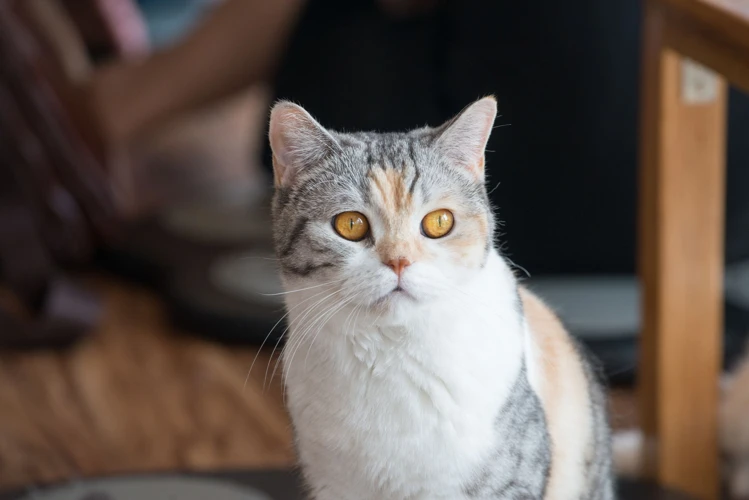
The coat colors of American Wirehair cats are not only fascinating but also inherited in specific ways. Understanding how these colors are passed on from one generation to the next can help breeders determine what combinations will produce which colors, allowing them to breed for specific characteristics.
Basic Genetics: Coat color inheritance in cats is determined by genetics. Each cat has two copies of each gene, one inherited from each parent. These genes are responsible for providing color variations in the fur.
Dominant and Recessive Genes: In general, genes that produce darker colors are dominant over those that produce lighter colors. For instance, the gene responsible for black coats is dominant over the gene for brown coats. However, when two cats with different coat colors mate, the resulting kittens may inherit one dominant gene from each parent and, therefore, exhibit a blend of colors.
Sex-linked Genes: Some coat colors are linked to the cat’s sex chromosomes. Male cats have one X chromosome and one Y chromosome, while female cats have two X chromosomes. The X chromosome contains the genes for coat color, so any color gene on the X chromosome will be expressed in a female cat. In contrast, male cats only inherit one X chromosome, so any color gene on that chromosome will be expressed regardless of whether it is dominant or recessive.
Polygenic Traits: Some coat colors are polygenic, which means they are controlled by more than one gene. This makes predicting the coat color of offspring more difficult, as each offspring receives different combinations of the genes from each parent.
Understanding the inheritance of American Wirehair cat coat colors is an important consideration for breeders and cat owners alike. Knowing the basics of genetics and how coat color traits are passed down from one generation to the next can help predict the potential coat colors of offspring, and also determine the compatibility of certain cats for breeding purposes.
Basic Genetics
When it comes to understanding the color variations of American Wirehair cats, it’s important to have a basic understanding of genetics. Genetics plays a crucial role in determining the coat color and patterns of this breed. By understanding the basics of genetic inheritance in cats, you can gain insight into the colors and patterns that can potentially appear in an American Wirehair cat. Let’s explore the basic principles of genetics and how they relate to the coat colors and patterns of American Wirehair cats.
Dominant and Recessive Genes
When it comes to the inheritance of American Wirehair cat coat colors, understanding dominant and recessive genes plays a crucial role. Dominant genes are the ones that are always expressed, even if only one copy is present in an individual’s DNA. On the other hand, recessive genes require two copies (one from each parent) to be expressed. Let’s take a closer look at how these genes work and how they affect the fur color of American Wirehair cats.
- Dominant Genes: A dominant gene is represented by a capital letter (e.g., “B”). This type of gene will always be expressed if present in an individual’s DNA. For example, a cat with the “B” gene for black fur color will always have black fur, no matter what other genes it carries.
- Recessive Genes: A recessive gene is represented by a lowercase letter (e.g., “b”). This type of gene will only be expressed if an individual has two copies of it (one from each parent). For example, a cat with the “bb” genotype for black fur color will have black fur, but a cat with only one “b” gene (Bb genotype) will have a different fur color, as the dominant “B” gene will be expressed.
- Co-dominance: Sometimes, two different dominant genes can be present in an individual’s DNA. In this case, both genes will be expressed equally, resulting in a blend of both traits. For example, a gray and white cat may have both the “B” gene for black fur and the “W” gene for white fur, resulting in a coat that’s a mix of both colors.
Understanding dominant and recessive genes is important for predicting the potential fur colors of American Wirehair cat offspring. By knowing which genes are dominant and which are recessive, breeders can make informed choices to produce cats with specific fur colors. However, it’s important to note that coat color is just one aspect of a cat’s genetics, and factors like health and temperament should also be taken into consideration when breeding cats.
Sex-linked Genes
Sex-linked genes are those genes that are present on either of the two sex chromosomes. In cats, the sex chromosomes are labeled as X and Y. Females have two X chromosomes while males have one X and one Y chromosome.
1. X-Linked Recessive Traits
X-linked recessive traits are carried on the X chromosome and are expressed only in males. Due to the presence of only one X chromosome in males, if they inherit an X chromosome carrying a recessive gene, then the trait will be expressed. In American Wirehair cats, some coat colors such as red and cream are associated with the X chromosome.
2. Tortoiseshell and Calico Color Patterns
Tortoiseshell and calico color patterns are also linked to the X chromosome. These patterns are formed due to the presence of two or more different coats of color on the same cat. However, male cats have only one X chromosome. This means that male cats have only one chance to inherit the genes responsible for these patterns, while female cats have two chances since they have two X chromosomes.
3. Dominant White Gene
The dominant white gene is also linked to the X chromosome. This gene is responsible for a solid white coat, and it is inherited similarly to the tortoiseshell and calico genes.
4. Y-Linked Traits
The Y chromosome in male cats is responsible for the development of male-specific traits. However, there are very few traits that are linked to the Y chromosome in cats. The most notable one is the SRY gene, which is responsible for the development of male reproductive organs.
Understanding sex-linked genes and their inheritance is crucial for breeders who want to produce certain coat colors or patterns in their American Wirehair cats.
Polygenic Traits
Polygenic traits are inherited traits that are controlled by multiple genes and environmental factors. This means that the color of an American Wirehair cat’s coat is not only determined by a single gene, but by multiple genes working together.
Examples of Polygenic Traits in American Wirehair Cats:
| Trait | Description |
|---|---|
| Fur Texture | The American Wirehair cat’s unique wiry coat is a result of multiple genes working together to create the texture and appearance of the fur. |
| Eye Color | The color of an American Wirehair cat’s eyes is determined by multiple genes, including those that control the production of melanin and other pigments. |
| Ear Shape | The shape of an American Wirehair cat’s ears is determined by multiple genes, which can result in varying degrees of curl or straightness. |
Understanding the role of polygenic traits in coat color and other physical characteristics is important for breeders and owners who want to produce or maintain certain traits in their American Wirehair cats. While the inheritance of these traits can be complex, careful breeding and attention to environmental factors can help to create and maintain the desired traits in future generations.
Grooming Tips for American Wirehair Cats
Keeping an American Wirehair cat’s coat healthy and shiny shouldn’t be a daunting task. These cats have a unique wiry coat that doesn’t shed excessively, making them low-maintenance pets. However, regular grooming is necessary to prevent matting, tangles, and other coat problems. In this section, we’ll provide you with some grooming tips to ensure that your American Wirehair cat’s coat stays in top shape.
Brushing the wiry coat: American Wirehair cats’ wiry coats can be brushed with a slicker brush, comb, and steel comb. Brushing helps remove loose hair and dirt. You should brush your American Wirehair cat’s coat regularly, especially during the shedding season.
Bathing: Despite their unique wiry coat, American Wirehair cats do not require frequent baths. However, if your cat gets into something particularly dirty or smelly, a bath is necessary. When bathing your American Wirehair cat, use a mild shampoo and warm water. More importantly, make sure to rinse the coat thoroughly to avoid any shampoo residue.
Trimming: American Wirehair cats’ nails grow fast, and as such, require regular trimming. You can use nail clippers or a nail grinder to trim your cat’s nails. However, if you are not comfortable doing so, you can take your cat to a professional groomer.
Ear cleaning: American Wirehair cats should have their ears cleaned regularly. Ear infections are common in cats, and regular cleaning can help prevent them. Use a cotton ball or a soft cloth to clean inside your cat’s ears. If you notice any discharge or signs of infection, take your cat to the vet.
Dental care: It’s essential to keep your American Wirehair cat’s teeth clean and healthy. Brush your cat’s teeth regularly using a soft brush and cat toothpaste. You can also offer dental treats and toys to help keep your cat’s teeth clean.
By following these grooming tips, you can help keep your American Wirehair cat’s coat healthy and in top condition. Regular grooming also helps build a bond between you and your cat. Always consult your vet if you have any concerns about your cat’s coat.
Conclusion
In conclusion, American Wirehair cats are a unique breed with a variety of beautiful coat colors and patterns. From brown tones to points to calico and tortoiseshell, these cats are sure to stand out in any room. Additionally, understanding the inheritance of coat colors can be helpful in predicting the potential coats of future litters.
It’s important to note that grooming plays a crucial role in maintaining the beauty of the American Wirehair coat. Regular grooming sessions can help prevent matting and maintain the unique texture of their fur.
Overall, American Wirehair cats are a wonderful addition to any household, bringing both a unique appearance and a loving personality. Understanding their coat colors and patterns can help owners appreciate the beauty of this breed even more.
Frequently Asked Questions
What is the origin of American Wirehair cats?
American Wirehair cats are believed to have originated in the United States in the 1960s. They are a result of a spontaneous mutation in a farm cat in upstate New York.
What are the unique characteristics of American Wirehair cats?
One of the most distinctive features of the American Wirehair cat is their wired, curly fur. They also have a muscular build and a round face with big eyes and wide-set ears.
How many different colors and patterns can American Wirehair cats have?
American Wirehair cats can have a variety of colors and patterns including solid colors, bi-colors, tri-colors, tabby patterns, and calico/tortoiseshell.
Do American Wirehair cats shed a lot of fur?
While American Wirehair cats do shed, their wiry, curly fur tends to not shed as much as other cat breeds. Regular grooming can help decrease shedding even further.
What is the temperament of American Wirehair cats?
American Wirehair cats are known for being friendly, playful, and affectionate. They tend to get along well with other pets and children, making them a great addition to families.
How often should I groom my American Wirehair cat?
It is recommended to groom your American Wirehair cat at least once a week to prevent matting and tangles in their wiry fur. Brushing can also help distribute oils throughout their coat for a healthy shine.
Are American Wirehair cats prone to any health issues?
While American Wirehair cats don’t have any breed-specific health issues, like all cats, they can develop health problems such as obesity, dental issues, and kidney disease. Regular vet check-ups and preventative care can help keep them healthy.
Can American Wirehair cats live in apartments?
Yes, American Wirehair cats can adapt well to living in apartments as long as they have plenty of space to play and exercise. Regular playtime and toys can help keep them active and happy in a smaller living space.
Do American Wirehair cats get along with other pets?
American Wirehair cats are known for their sociable nature and tend to get along well with other cats and even dogs when introduced properly and with patience. Proper introductions and supervision are important to ensure a peaceful household.
What is the lifespan of American Wirehair cats?
On average, American Wirehair cats have a lifespan of 12-15 years with proper care and regular vet check-ups. Some can even live into their late teens or early twenties with good health and care.

